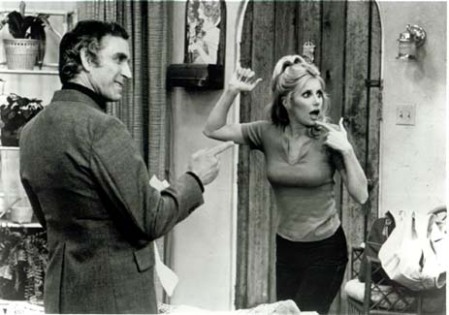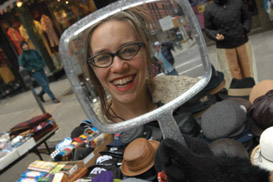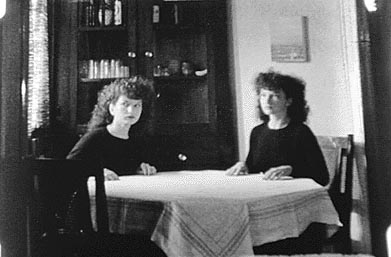 In Pen-Ek Ratanaruang’s 2003 film Last Life in the Universe, the main character, Kenji, is a quiet Japanese librarian living in Thailand. He takes his librarianism very seriously and obsessively organizes everything in his life (the neatly stacked books pictured here are in his house — and actually look quite a bit like the neatly stacked books in my house….). His continual attempts to commit suicide are always interrupted at a critical moment, and one attempt brings him together with Noi, a Thai bar-girl whose sister is hit by a car on a bridge that Kenji is trying to jump off of. In an attempt to avoid certain problems in his life, Kenji stays with Noi in her isolated home for a few days. Lots of things happen under the surface, and librarianism in general is left behind as the movie comes to its inevitable conclusion, but I still think that librarians (and everyone really) will really enjoy the interplays between organization and chaos (both physical and emotional) that permeate this film.
In Pen-Ek Ratanaruang’s 2003 film Last Life in the Universe, the main character, Kenji, is a quiet Japanese librarian living in Thailand. He takes his librarianism very seriously and obsessively organizes everything in his life (the neatly stacked books pictured here are in his house — and actually look quite a bit like the neatly stacked books in my house….). His continual attempts to commit suicide are always interrupted at a critical moment, and one attempt brings him together with Noi, a Thai bar-girl whose sister is hit by a car on a bridge that Kenji is trying to jump off of. In an attempt to avoid certain problems in his life, Kenji stays with Noi in her isolated home for a few days. Lots of things happen under the surface, and librarianism in general is left behind as the movie comes to its inevitable conclusion, but I still think that librarians (and everyone really) will really enjoy the interplays between organization and chaos (both physical and emotional) that permeate this film.
Last Life in the Universe
February 28, 2007FINALLY
February 25, 2007Wednesday’s New York Times had a reasoned, detailed story on Middlebury’s “no wikipedia” decree. The whole story, thank god. And it’s the first time in recent memory that I’ve seen scholarly bibliography discussed in the context of undergraduate education.
The debate around Middlebury isn’t so much an issue of credibility or scholarly worth, because, for the most part, Wikipedia is a broad and superior reference tool. (As an archivist, when looking for the repositories which hold papers of individuals or organizations, Wikipedia is one of the first things I turn to.) Rather, it points to the gaping hole of information literacy/bibliographic method in college teaching and academic libraries. Students have a hard time reasoning what reference works are for, and how they might fit into scholarly research. It has a lot to do with changes in higher ed (big classes, adjunct teachers, less writing, less research), but also with bibliographic tools that are subpar, inconsistent, and confusing. The OPAC is insulting, and print scholarly indexes went broke and their commercial counterparts are spotty and incomprehensive. So introducing students to reference sources as a starting point to inquiry, and not an end-answer, requires more from everyone. If a history department in a decent, expensive, and intimate school like Middlebury can’t take care of this, everyone else is in trouble.
What made the Times piece different from the dozens of others, is that they kinda got this. And they went so far to find a Columbia professor who did as well. Projects like those described in the article, where students had to “describe and analyze resources like libraries, reference books and newspapers. With 16 contributors, including the professor, the project comprises dozens of articles, including 13 on different Japanese dictionaries and encyclopedias,” actually teach critical skills for doing research and evaluating others’ work, rather than expecting that students will learn them on their own, within a context that’s in flux.
IKEA vs. History
February 24, 2007IKEA makes way for a Brooklyn store location and throws away all the historic shipyard documents in the buildings they knock down. Who needs history when you can have all the cheaply built yuppie furniture your studio apartment can hold?
Who really cares about this “scrotum” business?
February 23, 2007As an uppity librarian, I harbor similar contempt towards my colleagues who only really read YA novels ( “Read a book written for someone who’s over 12!”) as I did as an uppity riot grrrl towards my peers who only really read books written by Sister Spit members. (“Couldn’t you at least read George Eliot?!”)
But honestly, there’s no resisting the YA novel written by a Sister Spit alum. And so I was delighted to see in an airport bookstore yesterday, between French Women Don’t Get Fat and The No Asshole Rule, Michelle Tea’s trade paperback YA novel, Rose of No Man’s Land. (Published by HBJ, with a blurb from People, seriously.) So delighted, that I bought it and read it in an hour. It’s timely and angry- in the first three pages, Michelle Tea riffs on sexual abuse, the war in Iraq, class consciousness, reality tv and cancer culture, all in perfect pitch girl prose. In a way, it’s her most inspiring work to date. Destined to become a classic of teen queer experimental narrative, it made me hopeful for YA in a whole new way, and wonder “where have I been”?
The End
February 21, 2007 Recently a friend loaned me a copy of Rainbows End by Vernor Vinge (2006). I should fully disclose that, while I really love reading science fiction, I mostly make my sci-fi reading decisions based on neat covers that I like, so I haven’t delved that far into the Vinge back-list. And apparently I should, because he has some rather devoted fans out there.
Recently a friend loaned me a copy of Rainbows End by Vernor Vinge (2006). I should fully disclose that, while I really love reading science fiction, I mostly make my sci-fi reading decisions based on neat covers that I like, so I haven’t delved that far into the Vinge back-list. And apparently I should, because he has some rather devoted fans out there.
Although I had some plot-based problems with this book, there is more than enough technology and library-related goings on to make even the most anti-sci-fi librarian take note. The story takes place in the year 2025, primarily in San Diego. In this future world, our Web 2.0 has blossomed into an all-encompassing connected environment that people access by “wearing” – which involves a combination of technologically-implanted clothes and contact lenses that allow you to access the ever-present web of information at all times. When someone is “wearing” they can activate different visual overlays on the physical environment around them, project a 3-D version of themselves anywhere on Earth, and sort through megabytes of data, opinions, and information at the drop of a hat.
Naturally, in a world such as this, the younger generation doesn’t have much use for physical books. In fact, using their “wearable” net is so ingrained in their idea of learning, research, and communication, that books or journals that haven’t been digitized may as well never have existed.

Since this takes place in San Diego, Vinge nicely sets much of the library end of the plot at the Giesel Library on the UCSD campus. Here we have a semi-well-intentioned, but evilish project in which a big company is basically shredding all the books in the library as part of a fast-track digitization scheme. See, by shredding the books and comparing the scanned and shredded bits with other shredded copies, computers put together all the pieces into a totally searchable, integrated, digital product. The only problem is that the books are destroyed (gasp!). They are saving the shreds, though, in case future researchers want to take a look at them. (Shreddy Archives!)
Beyond the shredding project, Vinge explores the possibility of layering very detailed virtual reality skins over the gutted library (so users can experience the act of doing research as if they were in some Terry-Pratchett-like world – physical “virtual” books are delivered to them in a sort of Medieval D&D setting with changing content depending on their research interests), and the climactic scene of the book involves a library riot between competing fan groups that want control of the virtual way in which the library is presented.
There’s a lot more to it, but I think this should give you the general idea. In reading some reviews online, the consensus seems to be that this is not one of Vinge’s best books, but if you are a librarian or information-enthusiast who is interested in some not-so-distant-future technology ideas, I say: check it out.
synth on synth
February 21, 2007This “blink and you miss it” article from last week’s New York Times is a peek into the alchemy of preserving modern art. The Getty Conservation Institute‘ s web page is worth a look as well, with lots of information on the science and practice of preservation/conservation.
is the web female?
February 21, 2007This piece, “Say Everything,” from last week’s New York magazine has gotten a bit of play in library blogs, with some of the usual “look at what web 2.0 means for young people” talk. To be fair, New York‘s readership isn’t Middle-America’s librarians, and nor should it be. I read Emily Nussbaum’s stuff from time to time, and she usually handles gender with about as much tact and class as journalists can. But what I found missing from this article was just that- any mention of what Web 2.0, and “young people revealing their lives on the internet” means in terms of gender and power.
As libraries ape the commercial web, we talk about how we might adapt Web 2.0 tools in a way that empowers our users. It’s an odd choice of rhetoric, because in my mind, we want to promote social justice, not just give more consumer options. As the Web looks and works now, as Nussbaum portrays it, I want nothing to do with a library organization or a professional community that buys in without critique.
I’m someone who has grown up with the web, opted into the prevalent social web, scanned Cobrasnake for friends’ pictures, and has, as all these articles say, come to see the internet as integral to social life. So I feel like I’m not a naysaying adult when I say, some aspects of the social web are downright pernicious, and that aspects of the commercial web are really dis-empowering to young women. I think I can also speak from experience (because I have absolutely no data to support this) to say that women and girls are documenting their lives in fuller, more particular detail on the social web than men, and that this is the driving force behind many, if not all of the major Web 2.0 trends. Lastly, the internet is becoming some large exercise in the male gaze- whether it’s corporate behemoths owning Myspace thus owning a generation’s self representation, or party scene sites giving opportunistic ogling dudes unprecedented social power.
Nussbaum does a decent job of showing , rather than telling this, with her subjects being largely female, and her narrative of how the social web came to be starting with viral sex videos. With suprisingly little horror, she tells how the dudes who started CollegeHumor (basically low scale Girls Gone Wild) are now running Vimeo (a “hipster You Tube”, she says).

As a librarian, I do relish the occasion to seem priggish. But I also wonder what we can do to navigate, and maybe, preserve, the document of global society that is the social web. Can we, a profession that is largely female, and ambigiously dedicated to promoting social justice, conscionably adapt without question trends that are rooted in exploitation and greed? There has never been a more complete snapshot of female life than there is now on Myspace, Facebook, and livejournal. But who owns them, and who will own them in the future?



 Posted by kristy
Posted by kristy 
